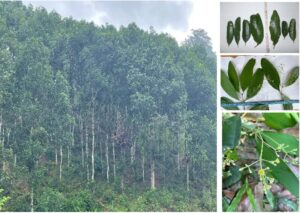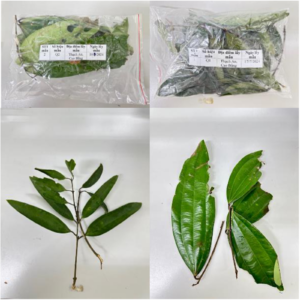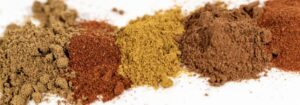REPORT OF RESULTS: DNA testing of 02 plant samples using the molecular barcode identification method.
IMAGE CATALOG
Figure 1. Condition of plant samples upon receipt
Figure 2. Results of total DNA extraction from 02 plant samples
Figure 3. PCR results of 02 plant samples with identification primers
Figure 4. Peaks of sequencing products
Figure 5. Signals of nucleotide sequences of sequencing products
Figure 6. Comparison of ITS sequences of 02 samples with reference sequences Figure 7. Phylogenetic tree of 02 plant samples with rpoB sequences of Cinnamomum sp.
Figure 8. Comparison of rpoB sequences of 02 samples with reference sequences Figure 9. Phylogenetic tree of 02 plant samples with matK sequences of Cinnamomum sp.
Figure 10. Comparison of matK sequences of 02 samples with reference sequences
Figure 11. Phylogenetic tree of 02 plant samples with rbcL sequences of Cinnamomum sp.
Figure 12. Comparison of rbcL sequences of 02 samples with reference sequences
TABLE OF CONTENTS
1. MATERIALS AND METHODS……………………………………………………………………4
1.1. Material ………………………………………………………………………………………………4
1.2. DNA Extraction Method……………………………………………………………………….5
1.3. Method for Checking DNA Purity and Concentration………………………………5
1.4. PCR Method ………………………………………………………………………………………..6
1.5. Sequencing Method ………………………………………………………………………………6
1.6. PCR Product Purification Method…………………………………………………………6
1.7. Data Processing Method……………………………………………………………………….6
3. Results …………………………………………………………………………………………………….7
3.1. Total DNA Extraction Results……………………………………………………………………..7
3.2. PCR results of identifying primers…………………………………………………………..7
3.3. Sequencing results of PCR products with identification markers………………..8
3.4. ITS sequence analysis results of 02 plant samples…………………………………….9
ITS sequence sample QN01………………………………………………………………………9
ITS sequence sample QN02…………………………………………………………………….10
3.5. Genbank BLAST results…………………………………………………………………..10
3.6. ITS sequence difference analysis of 02 identification samples and reference sample…………………………………………………………………………………..10
3.7. Results of rpoB sequence analysis of 02 plant samples……………………………10
rpoB sequence sample QN01…………………………………………………………………..10
rpoB sequence sample QN02…………………………………………………………………..11
Phylogenetic tree with published rpoB sequences of Cinnamomum sp………….11
Analysis of rpoB sequence differences of 02 identification samples and reference sample …………………………………………………………….12
3.8. Results of matK 02 sequence analysis of plant samples………………………….12
Sample matK sequence QN01…………………………………………………………………12
Sample matK sequence QN02…………………………………………………………………13
3.9. Phylogenetic tree with published matK sequences of Cinnamomum sp…13
Analysis of matK sequence differences of 02 identification samples and
reference sample……………………………………………………………………………………14
3.10. Results of rbcL sequence analysis of 02 plant samples…………………………..14
rbcL sequence sample QN01…………………………………………………………………..14
rbcL sequence sample QN02…………………………………………………………………..15
Taxonomic tree with published rbcL sequences of genus Cinnamomum sp……15
Analysis of rbcL sequence differences of 02 identification samples and reference sample……………………………………………………………… 16
4. CONCLUSION…………………………………………………………………………………………16
1. MATERIALS AND METHODS
1.1. Materials
– 02 plant leaf samples are marked: QN01; QN02
– Sample condition: stored in zip bag, old, hard leaf sample, rich in essential oil.
04 identification primer:
Bảng 1. Sequences of ITS 2 primer and matK primer
1.2. DNA extraction method
|
Bảng 2. Wash buffer components
– – Take 0.5 – 1.0 g of collected leaves and 2 ml eppendorf, put 2 balls in each tube
– Put each eppendorf tube into the sample grinder adapter. Soak the eppendorf tube and the sample grinder adapter in liquid nitrogen for 4 minutes.
– Insert the adapter soaked in liquid nitrogen into the grinder. Set the vibration frequency to 22 rpm and 4 minutes. The sample must be left in the adapter until the extraction buffer or washing buffer is added
– The samples are processed through the sample washing buffer until the washing solution is clear, add 1.5 ml of washing buffer to each sample, mix well. Use a magnet to pull the iron balls out of the eppendorf tube. Centrifuge at 12000 rpm/5 minutes. Collect the residue, discard the supernatant.
– The sample is washed until the washing solution is clear and free of viscosity and color of secondary compounds. The average washing with a sample rich in essential oils such as the Cinamum family is 8 to 9 times.
– After removing secondary compounds, the sample is extracted using Vazyme’s FastPure Plant DNA Isolation Mini kit.
1.3. Methods for testing DNA purity and concentration
– Total DNA was then examined on 1% agarose gel and measured for content and purity using a Jasco V-730 Spectrophotometer. The DNA of these samples was diluted to the same concentration of 50ng/µl and kept at -20oC for subsequent experiments.
1.4. PCR method
– The PCR reaction with the optimal primer annealing temperature was performed on the PCR Proflex machine (Appied Biosystem, USA) according to the designed temperature range. The PCR reaction was performed on the PCR System 9700 machine (Appied Biosystem, USA) with a total volume of 50 µl/sample containing the following components and concentrations of the reactants:
Figure 3. PCR reaction components
| Components | Reaction (µl) |
| DreamTaq Green Master Mix 2X | 12,5 |
| Mồi | 1 |
| Mẫu DNA | 2 |
| Nước | 9,5 |
Figure 4. Thermal cycling for PCR reaction
| Step | React | Temp | Time (minutes) | Period |
| 1 | Denaturation | 94 | 4 | 35 |
| 2 | Denaturation | 94 | 1 | |
| 3 | Attach the bait | Ta | 0.5 | |
| 4 | Lengthen the chain | 72 | 1 | |
| 5 | Complete chain extension | 72 | 10 | |
| 6 | End of reaction | 10 | ∞ |
1.5. Sequencing method
PCR products were sequenced using the Sanger method.
1.6. PCR product purification method
PCR products after being checked on 1% agarose gel, 70 V current for 40 minutes, checked under UV light. Use a knife to cut the electrophoresis tape and put it into an eppendorf tube, using the DNA purification kit on the gel….
[Download to read all documents >>>]





